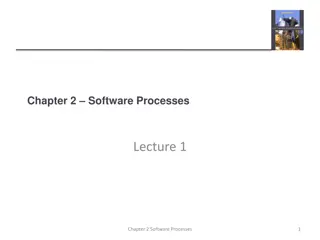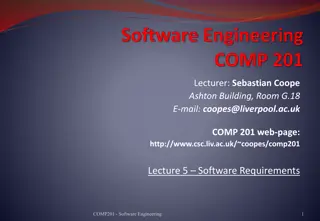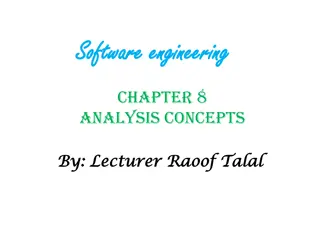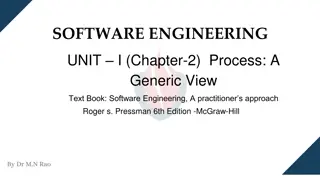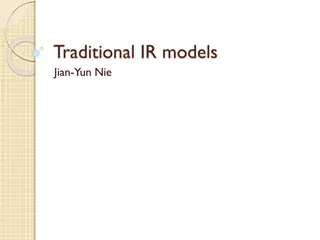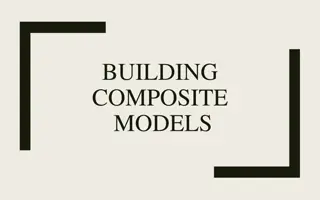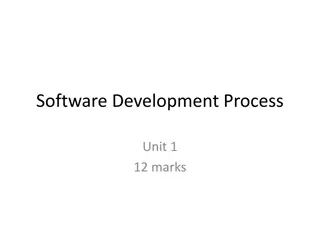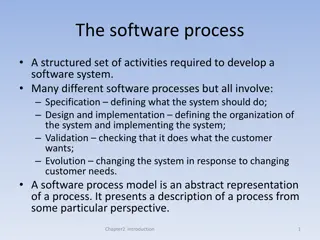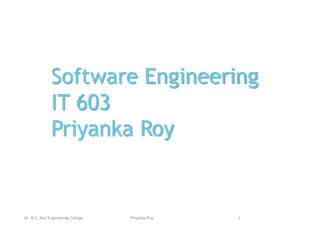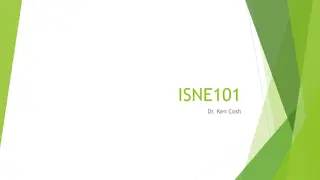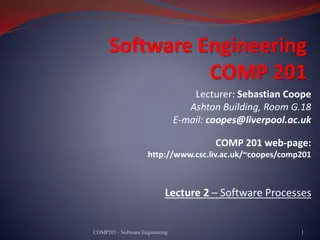Overview of Software Processes and Models
This content delves into the fundamental aspects of software processes, discussing the structured activities involved in developing a software system, various process models, and the distinction between plan-driven and agile approaches. It emphasizes the importance of specification, design, validation, and evolution in software development processes. Additionally, it explores process descriptions, product outcomes, roles, and pre- and post-conditions. The text also touches upon popular software process models like the waterfall model, incremental development, and integration and configuration.
Download Presentation

Please find below an Image/Link to download the presentation.
The content on the website is provided AS IS for your information and personal use only. It may not be sold, licensed, or shared on other websites without obtaining consent from the author.If you encounter any issues during the download, it is possible that the publisher has removed the file from their server.
You are allowed to download the files provided on this website for personal or commercial use, subject to the condition that they are used lawfully. All files are the property of their respective owners.
The content on the website is provided AS IS for your information and personal use only. It may not be sold, licensed, or shared on other websites without obtaining consent from the author.
E N D
Presentation Transcript
Chapter 2 Software Processes 30/10/2014 Chapter 2 Software Processes 1
Topics Covered 1- software process models 2- process activities 30/10/2014 Chapter 2 Software Processes 2
The software process A structured set of activities required to develop a software system. Many different software processes but all involve: Specification defining what the system should do; Design and implementation defining the organization of the system and implementing the system; Validation checking that it does what the customer wants; Evolution changing the system in response to changing customer needs. A software process model is an abstract representation of a process. It presents a description of a process from some particular perspective. 30/10/2014 Chapter 2 Software Processes 3
Software process descriptions When we describe and discuss processes, we usually talk about the activities in these processes such as specifying a data model, designing a user interface, etc. and the ordering of these activities. Process descriptions may also include: Products, which are the outcomes of a process activity; Roles, which reflect the responsibilities of the people involved in the process; Pre- and post-conditions, which are statements that are true before and after a process activity has been enacted or a product produced. 30/10/2014 Chapter 2 Software Processes 4
Plan-driven and agile processes Plan-driven processes are processes where all of the process activities are planned in advance and progress is measured against this plan. In agile processes, planning is incremental and it is easier to change the process to reflect changing customer requirements. In practice, most practical processes include elements of both plan-driven and agile approaches. There are no right or wrong software processes. 30/10/2014 Chapter 2 Software Processes 5
Software process models 30/10/2014 Chapter 2 Software Processes 6
Software process models The waterfall model Plan-driven model. Separate and distinct phases of specification and development. Incremental development Specification, development and validation are interleaved. May be plan-driven or agile. Integration and configuration The system is assembled from existing configurable components. May be plan-driven or agile. In practice, most large systems are developed using a process that incorporates elements from all of these models. 30/10/2014 Chapter 2 Software Processes 7
The waterfall model 30/10/2014 Chapter 2 Software Processes 8
Waterfall model phases There are separate identified phases in the waterfall model: Requirements analysis and definition System and software design Implementation and unit testing Integration and system testing Operation and maintenance The main drawback of the waterfall model is the difficulty of accommodating change after the process is underway. In principle, a phase has to be complete before moving onto the next phase. 30/10/2014 Chapter 2 Software Processes 9
Waterfall model problems Inflexible partitioning of the project into distinct stages makes it difficult to respond to changing customer requirements. Therefore, this model is only appropriate when the requirements are well-understood and changes will be fairly limited during the design process. Few business systems have stable requirements. The waterfall model is mostly used for large systems engineering projects where a system is developed at several sites. In those circumstances, the plan-driven nature of the waterfall model helps coordinate the work. 30/10/2014 Chapter 2 Software Processes 10
Incremental development Chapter 2 Software Processes 11 30/10/2014
Incremental development benefits The cost of accommodating changing customer requirements is reduced. The amount of analysis and documentation that has to be redone is much less than is required with the waterfall model. It is easier to get customer feedback on the development work that has been done. Customers can comment on demonstrations of the software and see how much has been implemented. More rapid delivery and deployment of useful software to the customer is possible. Customers are able to use and gain value from the software earlier than is possible with a waterfall process. 30/10/2014 Chapter 2 Software Processes 12
Incremental development problems The process is not visible. Managers need regular deliverables to measure progress. If systems are developed quickly, it is not cost-effective to produce documents that reflect every version of the system. System structure tends to degrade as new increments are added. Unless time and money is spent on refactoring to improve the software, regular change tends to corrupt its structure. Incorporating further software changes becomes increasingly difficult and costly. 30/10/2014 Chapter 2 Software Processes 13
30/10/2014 Chapter 2 Software Processes 14
30/10/2014 Chapter 2 Software Processes 15
Incremental delivery Rather than deliver the system as a single delivery, the development and delivery is broken down into increments with each increment delivering part of the required functionality. User requirements are prioritised and the highest priority requirements are included in early increments. Once the development of an increment is started, the requirements are frozen though requirements for later increments can continue to evolve. 30/10/2014 Chapter 2 Software Processes 16
Incremental delivery 30/10/2014 Chapter 2 Software Processes 17
Incremental delivery advantages Customer value can be delivered with each increment so system functionality is available earlier. Early increments act as a prototype to help elicit requirements for later increments. Lower risk of overall project failure. The highest priority system services tend to receive the most testing. 30/10/2014 Chapter 2 Software Processes 18
Incremental delivery problems Most systems require a set of basic facilities that are used by different parts of the system. As requirements are not defined in detail until an increment is to be implemented, it can be hard to identify common facilities that are needed by all increments. The essence of iterative processes is that the specification is developed in conjunction with the software. However, this conflicts with the procurement model of many organizations, where the complete system specification is part of the system development contract. 30/10/2014 Chapter 2 Software Processes 19
Software prototyping A prototype is an initial version of a system used to demonstrate concepts and try out design options. A prototype can be used in: The requirements engineering process to help with requirements elicitation and validation; In design processes to explore options and develop a UI design; In the testing process to run back-to-back tests. 30/10/2014 Chapter 2 Software Processes 20
Benefits of prototyping Improved system usability. A closer match to users real needs. Improved design quality. Improved maintainability. Reduced development effort. 30/10/2014 Chapter 2 Software Processes 21
The process of prototype development 30/10/2014 Chapter 2 Software Processes 22
Prototype development May be based on rapid prototyping languages or tools May involve leaving out functionality Prototype should focus on areas of the product that are not well- understood; Error checking and recovery may not be included in the prototype; Focus on functional rather than non-functional requirements such as reliability and security 30/10/2014 Chapter 2 Software Processes 23
Throw-away prototypes Prototypes should be discarded after development as they are not a good basis for a production system: It may be impossible to tune the system to meet non-functional requirements; Prototypes are normally undocumented; The prototype structure is usually degraded through rapid change; The prototype probably will not meet normal organisational quality standards. 30/10/2014 Chapter 2 Software Processes 24
Process activities 30/10/2014 Chapter 2 Software Processes 25
Process activities Real software processes are inter-leaved sequences of technical, collaborative and managerial activities with the overall goal of specifying, designing, implementing and testing a software system. The four basic process activities of specification, development, validation and evolution are organized differently in different development processes. For example, in the waterfall model, they are organized in sequence, whereas in incremental development they are interleaved. 30/10/2014 Chapter 2 Software Processes 26
The requirements engineering process 30/10/2014 Chapter 2 Software Processes 27
Software specification The process of establishing what services are required and the constraints on the system s operation and development. Requirements engineering process Requirements elicitation and analysis What do the system stakeholders require or expect from the system? Requirements specification Defining the requirements in detail Requirements validation Checking the validity of the requirements 30/10/2014 Chapter 2 Software Processes 28
Software design and implementation The process of converting the system specification into an executable system. Software design Design a software structure that realises the specification; Implementation Translate this structure into an executable program; The activities of design and implementation are closely related and may be inter-leaved. 30/10/2014 Chapter 2 Software Processes 29
A general model of the design process 30/10/2014 Chapter 2 Software Processes 30
Design activities Architectural design, where you identify the overall structure of the system, the principal components (subsystems or modules), their relationships and how they are distributed. Database design, where you design the system data structures and how these are to be represented in a database. Interface design, where you define the interfaces between system components. Component selection and design, where you search for reusable components. If unavailable, you design how it will operate. Chapter 2 Software Processes 30/10/2014 31
System implementation The software is implemented either by developing a program or programs or by configuring an application system. Design and implementation are interleaved activities for most types of software system. Programming is an individual activity with no standard process. Debugging is the activity of finding program faults and correcting these faults. 30/10/2014 Chapter 2 Software Processes 32
Software validation Verification and validation (V & V) is intended to show that a system conforms to its specification and meets the requirements of the system customer. Involves checking and review processes and system testing. System testing involves executing the system with test cases that are derived from the specification of the real data to be processed by the system. Testing is the most commonly used V & V activity. 30/10/2014 Chapter 2 Software Processes 33
Stages of testing 30/10/2014 Chapter 2 Software Processes 34
Testing stages Component testing Individual components are tested independently; Components may be functions or objects or coherent groupings of these entities. System testing Testing of the system as a whole. Testing of emergent properties is particularly important. Customer testing Testing with customer data to check that the system meets the customer s needs. 30/10/2014 Chapter 2 Software Processes 35
Software evolution Software is inherently flexible and can change. As requirements change through changing business circumstances, the software that supports the business must also evolve and change. Although there has been a demarcation between development and evolution (maintenance) this is increasingly irrelevant as fewer and fewer systems are completely new. 30/10/2014 Chapter 2 Software Processes 36
System evolution 30/10/2014 Chapter 2 Software Processes 37





